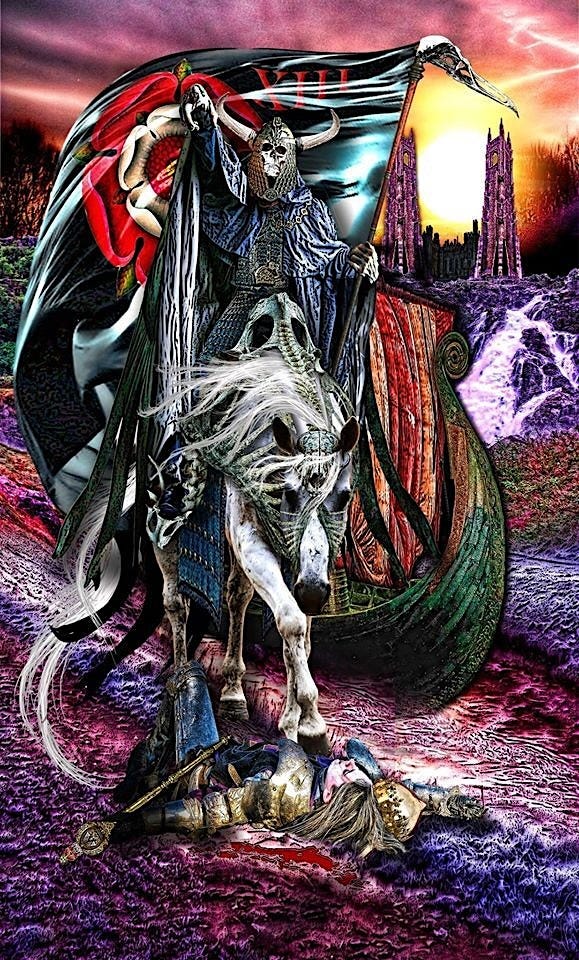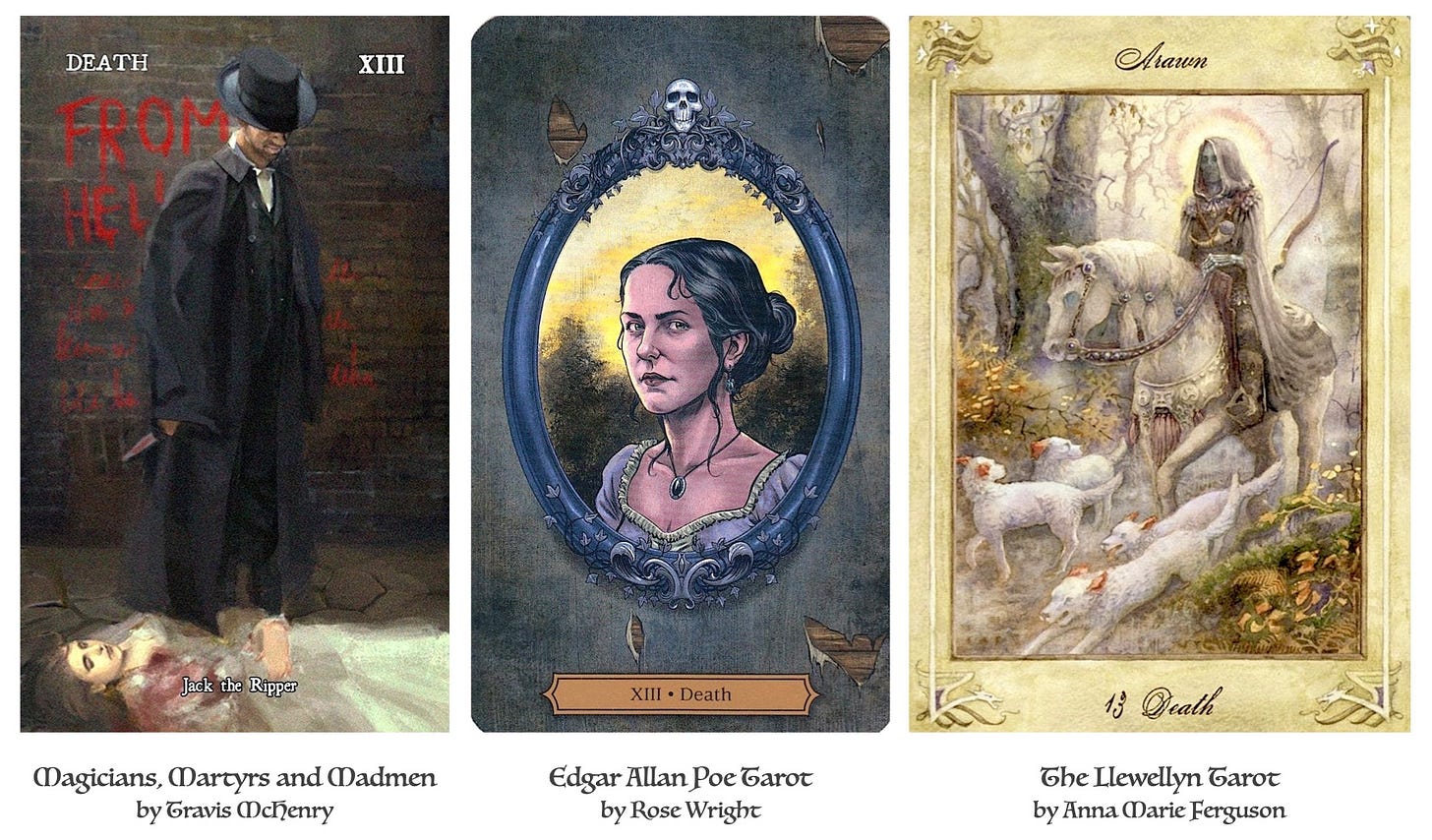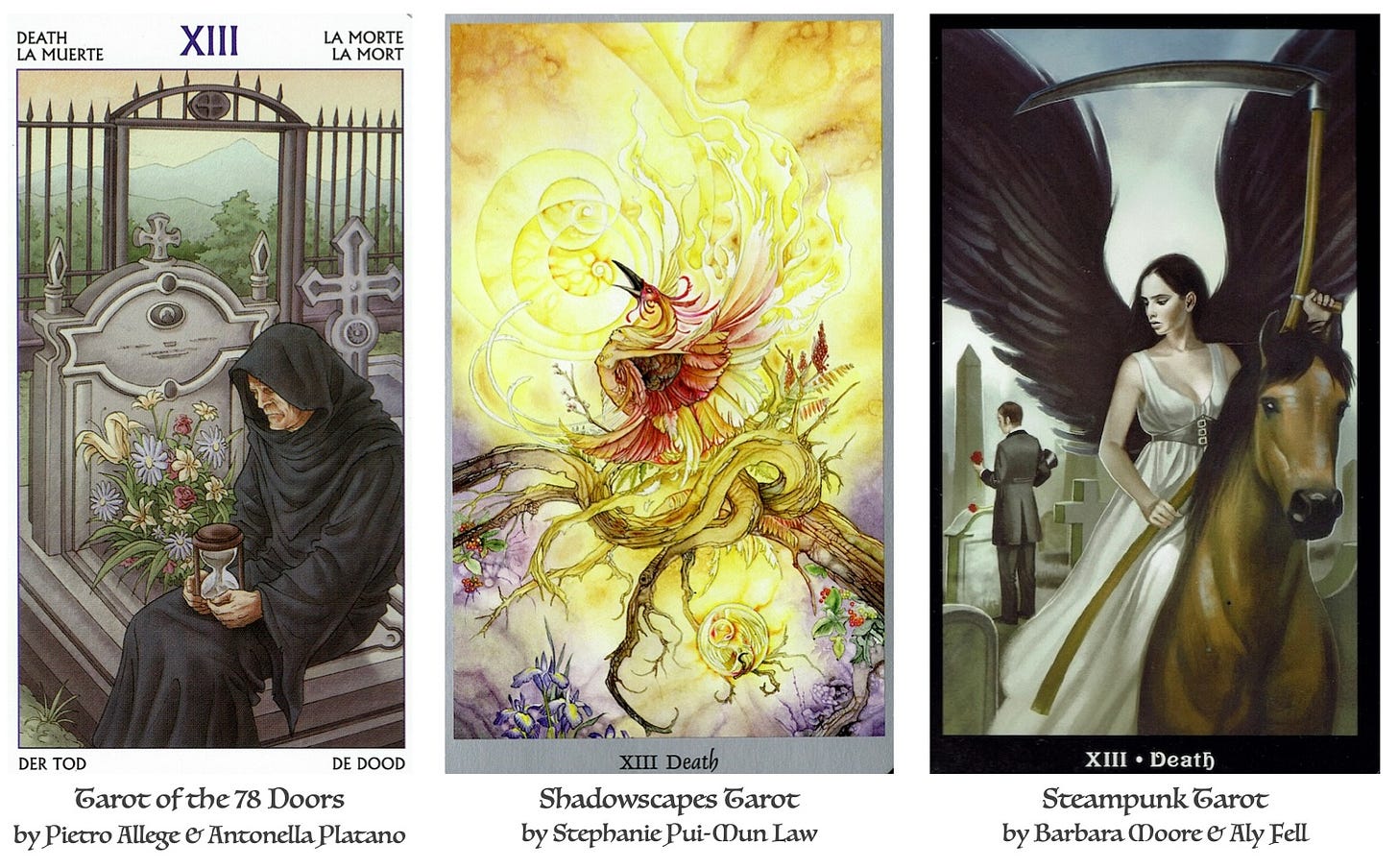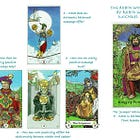XIII·Death from 12 different angles...
Two Tarotistas, six XIII·Death cards, and multiple layers of reading!
Welcome to this week’s post… it is co-authored with Helena of Scriptorium,
we hope you love it… 🤍
Helena writes:
You know, when you meet somebody who really gets you, the first thing you do is talking. Like, loads of it. This was the thing with Phil and me. Once we got talking, we realized we were on the tarot trail. And we've discussed how great it would be to collaborate, for about what, a month- when a brilliant idea hit one of us. I think it was obviously not me, and the suggestion was to take Death and have a ball [I think this was a joint idea… my memory is it just happened! I’m delighted to say - Phil 🙂].
I have about a hundred plus decks, - yeah, a recovering tarot hoarder- so the idea of picking three various Deaths seemed pretty wild. And brilliant, still.
So that's how this experiment was born. I do hope you'll enjoy the narrative- as we both did, and here’s to many happy returns, eh, Phil? 😊 [For sure! - Phil]
Phil writes:
What Helena said! 👍🏼
… and, what Andreas at Tarot Studies recently said too…
One of the (many) things I love about the tarot is how card meanings are an act of constant re-interpretation. They evolve with lived experience, language, and the multiplicity of ways through which we understand ourselves and the world... Its beauty lies in its endless capacity to generate new meaning—not in spite of its tradition, but because of it.1
So, with all of the above in mind, this post aims to look at XIII·Death, and continue generations of building on A. E. Waite’s:
13. DEATH.—End, mortality, destruction, corruption; also, for a man, the loss of a benefactor; for a woman, many contrarieties; for a maid, failure of marriage projects.2
Let’s Tarot…
Helena writes:
To begin, I love this card (above). Not only because I've worked with death in various aspects, and not only because my main patron gods were all death-related, but because it's such a wonderful, multilayered thing.
I remember the first Death that captured my imagination. It hailed from the Illuminati tarot above. The whole deck has something tudoresque about it, and you clearly see Elizabeth I and her awful dad in the swords suit. But the Death...it wasn't scary. It was triumphant, but not in a bad way- look.
For history nerds like me, it's clearly a Bosworth field memento. Richard is there, under the horse's hooves, and the Death is wearing a battle helmet. Not quite historically accurate, but it's there. What is more important, it has the Tudor rose on its flag, signalling the new beginning at the expense of an ending. There you go, Death as a harbinger of change.
However, it wasn't my first choice, that one is below.
Helena’s choices…
Helena writes:
My first choice was Death in the guise of Jack the Ripper from Travis McHenry's Magicians, Martyrs and Madmen deck.
This death has just happened. This death isn't triumphant at all, I'd call him pensive. He is there, but the future is uncertain. What is, however, is that nothing will ever be the same.
In that sense, Jack is the best Death representative, if you look for a revelatory, revolutionary death. Death that overturns, overthrows, rips apart the present, quite rigid and partly rotten state of things.
Next up, the Death of Edgar Allan Poe Tarot. To get her, you'd need to know the story. In a nutshell, lively and beautiful girl marries the artist, who paints all the time. They are different, but she loves him. One day he decides to paint her to which she reluctantly agrees. He paints as a madman, and when it's done, he exclaims that the portrait is life itself. He looks at her, and wham! - she's dead.
What do we get from it? The death is imminent, it robs us of all colors. All that is left is a portrait, a pale likeness, something to be placed on a tombstone. Death can be that. Death is something that comes as a thief in the night - but it's not to be sacrificed to. The message here is: re-evaluate. See what's really important. I guess, it wasn't the bloody portrait, after all.
The third one, well, it's mythological. In Welsh mythology, Arawn is the King Of the Otherworld. He is not death per se, but rather someone whose appearance signals change. You may find him in Y Mabinogi, in the tale of Pwyll, Prince of Dyfed. Arawn is the leader of the Wild Hunt as well, and he rides out in autumn to gather souls- and carry them off so they wouldn't bother the living. His white hounds see to that.
What does it tell us? Volumes. Death and dying are different things. Death can be merciful. Death is majestic. Death is a door to the new life. Which is amazing.
Phil writes:
These three cards are all wonderfully new to me, and I am reading them without the authors’ safety-nets! 😃 Although, Mr Google helped me a little here and there! 😉
When I look at both sets of images (above and below) the first thing that strikes me is our very first card is the only image where the featured character isn’t looking back. Jack the Ripper is a serial killer, and has just taken a life: so, Death on a smaller scale? Jack seems to me to be considering what he has done before deciding on his next move.
The difference between Jack and Death is that Death’s purpose is divine, whilst Jack’s is human and aberrant. In this card, I see untimely and unnatural death, and in a client reading I would want to ask, “what feels like it is being forced on you, right now?” or perhaps… “who do you identify most with in this image when you think about your question?”
For the second card I found myself adding Edgar Allan Poe: The Complete Collection to my Kindle, so that I could read the short story The Oval Portrait for contextual background. The story is vivid, gothic, atmospheric and everything you’d expect from Edgar Allan Poe. Helena summarises it beautifully above.
A beautiful girl dies because his obsession with her image causes her painter to lose sight of the real her. This is also death by neglect. In a reading this card would prompt me to ask a reflective question, “what changes happening around you right now are you not seeing clearly… are you missing what’s really happening because you are pre-occupied with something else?”
Or… maybe the Seeker relates to the plight of the beautiful girl, which suggests a different question like, “how can you make sure you are being heard right now?” because, your transformation is dependent on your being heard, especially by those who are not seeing the real you.
Finally Arawn, the Celtic God of the Underworld, a classic huntsman with dogs image. Mr Google told me that Arawn and his dogs are hunting down souls, especially those illegally resurrected by magic, who need to return to the Underworld. So, for me, this card points to nature’s laws surrounding death, especially the infraction of inappropriate magical resurrection!
Trying to escape a perpetual stay in the Underworld is not an option (for any of us 😀… is it? 🤔). Escape attempts are likely to result in noisy pursuit. Thunderous horses hooves, and baying hounds, are the soundtrack for the laws of death in this card. The end is inevitable, one way or another.
With a Seeker I would want to understand from them what they are currently refusing to let go of, or hoping to resurrect, in defiance of inevitable change, with questions like, “If you simply let this thing pass, what do you feel will be the benefit to you?” or “Can you see how much harder it is sometimes to fight the inevitable than to simply welcome change?”
Anaïs Nin comes to mind here…
“And the day came when the risk to remain tight in a bud was more painful than the risk it took to blossom.”
Phil’s choices
Phil writes:
I love these images, and how they help us here to draw out further layers of meaning in our understanding of XIII·Death.
I am especially drawn to the hourglass, in the first card. For me it emphasises the continual flow and limitations of time. The final grain of sand will flow through the narrow funnel between the globes… for us all. Yes, we could try spinning the hourglass to reverse the flow, but should we? If we do, how confident are we that we can outrun Arawn and his hounds of the Underworld!
In a reading, I would want to explore the client’s understanding of how time is influencing their question, exploring questions like, “has x run its natural course, do you think? What difference would having more time make?”, possibly, “How would you recognise the passing of the final grain of sand in this situation?”
In the second card, I am deeply in love with the idea of XIII·Death as a phoenix. These days I often read XIII·Death as rebirth in this way; the flames of rebirth purifying and translating what has passed into something still more remarkable and beautiful… and this image sums it up so beautifully!
In a client reading its appearance would be prompting me to ask, “could you see yourself in a better place once this is over?” or, “how will it feel, do you think, to have left all of the problems relating to this change in ashes?”
Looking at the final card, I am struck by the reality of our experience of death; it references mourning, reflection, respect, and… moving on… Death has other souls to gather, but in this image we can share her brief moment of compassion for those left behind. Endings can be sad, and that is ok… they are, however, a part of life, and there is always something next…
In a client reading, I might simply share this image with them and ask who would they identify most with in the image in terms of their question? Instigator, or mourner? I’d probably probe around, “what do you feel is coming to a natural end right now?” or, “how will you look back on, and honour, what has passed?”
Helena writes:
Phil's choices are quite interesting.
First one clearly speaks of grief as the natural companion of death. Grief is a good teacher, and grieving is letting go. Grieve, but do not grieve yourself to death- that's what this card is telling me.
A second one, of Shadowscapes, is the glorious one. Metamorphosis, life changing forms, a soul rising from the ashes into flames to be reborn. It's a beautiful cycle, and Death does have that power of transformation in it. Love it.
The third one reminds me of Neil Gaiman's Lady on the Grey, from The Graveyard book. Surprisingly, he didn't invent her, she's always been there in old stories. But, she's not there for the living trying to cope with death. She's there for the dead, to keep and guard them, to guide them on. She's a psychopomp, a guardian of the dead. And she's saying, what is dead, remains dead, but it shouldn't be forgotten. The dead shall not trouble the living, the living shall respect the dead.
So, it's more of a message to the living about respect and dignity of death, I think.
Conclusions…
Phil writes:
In the introduction to this piece I quoted Andreas, and his view that Tarot’s “beauty lies in its endless capacity to generate new meaning—not in spite of its tradition, but because of it.” What Helena and I have seen and written above shares this view, and it has been a real pleasure to work together discovering new and different meanings for cards we know, and those we’ve just met.
Someone once told me that as a Tarot Reader you get the clients you need (who also help you to understand more about yourself during the reading - I totally agree with this!). It has always made sense to me that there is a mirror image to this position, and Seekers will find the Reader they need, too.
If you look at any Tarot reading, Seekers face many variables; like… a Reader’s style, experience, their personal choice of decks from the tens of thousands available, so it is unsurprising that they will differ in places… I read once for a man, with a very direct style, who told me clearly, “that’s rubbish, that is, that’s not what my usual reader told me!” Shortly after that, fully refunded, he left! 😅
This man was looking for a different reading of the cards. I asked him what he’d expected, and he explained, pointing to VII·The Chariot still on the table in front of us, that his usual reader would have told him this meant a new car, and the Queen of Wands next to it meant that he was about to meet a beautiful blonde… I apologised to him, because I couldn’t see the cards that way, and many years later, still can’t… but there are some brilliant readers (including his) who can 🙂
Helena and I didn’t have such polar views of these cards, because ultimately we agreed on the fundamental principles of what XIII·Death represents for us as readers… with the key themes of death and rebirth running throughout our readings.
However, some of our differences in approach to XIII·Death have added layers of meaning that we’ll recall the next time we set any of these XIII·Death cards in front of an expectant, and possibly nervous, Seeker. Re-reading all of our responses above, here are some of the key ideas we can use to add more depth when these cards next find their way onto our reading cloths:
Death as a harbinger of change
… new beginning at the expense of an ending
Death is something that comes as a thief in the night
… nothing will ever be the same
Death is a door to the new life
… re-evaluate. See what's really important
Death’s purpose is divine
… it emphasises the continual flow and limitations of time
The end is inevitable, one way or another
… the flames of rebirth purifying and translating what has passed into something still more remarkable and beautiful
Can you see how much harder it is sometimes to fight the inevitable than to simply welcome change?
… what do you feel is coming to a natural end right now?
grief as the natural companion of death
Metamorphosis, life changing forms
… respect and dignity
All of the above is based on the premise that we are looking at XIII·Death as it relates to whatever question it is answering. It is an important card with a big, and often difficult, message for the Seeker, and should never be sugar-coated!3
I’ll leave our final words on XIII·Death to the late, brilliant, Rachel Pollack:
Sometimes in a reading we want to make a person feel better. We say that the Death card means rebirth, or change, or a new beginning. Actually, it means death. Something ends, and one way or another, it will feel like dying. Good things may come, but first we need to accept the end of what had existed. Even if something unpleasant dies, such as a painful relationship, we still may grieve for the loss of what we have known, how we have defined ourselves.4
We hope you have enjoyed this Substack and found something in it that may enhance your understanding of XIII·Death as either Reader, or Seeker. If you have enjoyed it, please consider subscribing to our free Substacks…
We welcome your thoughts on the above, and how this reading resonates (or not!) for you... please feel free to comment below (We are very open to respectful disagreement and discussion!) and also feel free to share this free post if you feel it might interest others, thanks... 😊
Love, light, and laughter... always,
Helena & Phil 🕯️
Phil picks up this point in his post, if you are interested in hearing more on this view…
Pollack, Rachel; Tarot Wisdom: Spiritual Teachings and Deeper Meanings. Llewellyn Publications, 2008.










Mister Phil, it's one mammoth of the thing! Great job!
Loved reading this post and seeing the similarities and differences of your approaches to the Death card! And thank you so much for the mention! 😊